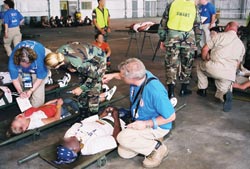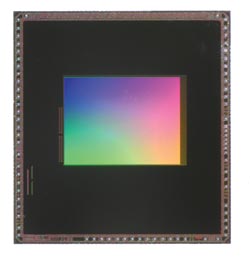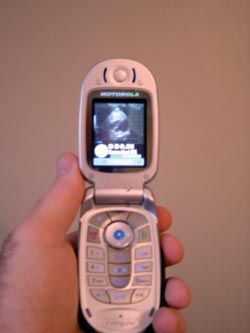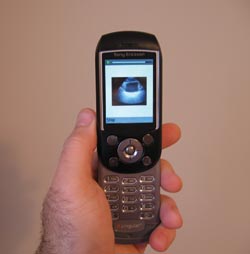Cell phones capture and transmit images for remote evaluation.
Anne L. Fischer, Senior Editor
Telemedicine gives patients access to a doctor no matter where they are. Whether a patient uses
monitoring equipment to send information to the doctor’s office or an
x-ray technician transmits images to a radiologist for examination, telemedicine
bridges the distance between the patient and the professional. However, many obstacles
have impeded its widespread implementation.
The communications infrastructures required to
transmit large images rapidly are not in place everywhere around the globe. Also,
some standards, including FDA approval, do not cover some tools and techniques that
would make the technology commonplace. However, a simple tool — the camera
phone — is being used by doctors, emergency responders, ultrasound technicians
and other health care professionals in telemedicine.

Emergency responders are using cell phone cameras to take images
of disaster scenes to send them ahead to emergency personnel at the hospital
before the injured arrive.
A camera phone can allow physicians
or technicians to capture and send images for evaluation without costly and bulky
imaging devices. Most consumers own a cell phone today. The “2006 Market Review
and Forecast” published by the Telecommunications Industry Association
of Arlington, Va., estimates that, in 2005, 66 percent of people in the US and more
than 77 percent in Europe owned a cell phone. And camera phone use passed regular
cell phones last year, according to a recently released study by market analyst
InfoTrends of Weymouth, Mass. The firm forecasts that, by 2010, 87 percent of all
mobile phones in use will be camera phones.
High-resolution camera phones
Taking an image with a camera phone is as easy
as using any digital camera, and the image can be sent to another camera phone user
or to an e-mail address for viewing on a computer or on a handheld device. Not long
ago, digital cameras had only 1-megapixel image sensors, but today, cell phones
have 3- to 5-megapixel sensors, and 8 megapixels are on the horizon, said Don Lake,
emerging technical marketing manager at Micron Technology Inc. of Boise, Idaho.
Micron recently introduced a 1/4-in. sensor that enables camera phones to capture images with a resolution of 1600 x 1200 pixels.

This 1/4-in., 2-megapixel image sensor incorporates Mobile Industry Processor Interface standards,
simplifying implementation in cell phones. It also has a system-on-chip sensor with
a microcontroller that boosts the quality of images, making camera phones as useful
as digital cameras in telehealth and other applications.
Today’s phones pack imaging and
connectivity into very small packages. Motorola Inc.’s new 640 x 480 cameras
come with 1-, 2- or 3-megapixel image sensors that include Bluetooth wireless technology.
The 3G V1050 mobile phone, which has a 1.3-megapixel camera, lets the user take
photos and hold conference calls with two-way video calling. Doctors are finding
that the resolution is good enough for their needs.
Dr. Michael Blaivas of the Medical
College of Georgia in Augusta uses a camera phone to send and receive ultrasound
images. He thinks that today’s camera phones are adequate but not optimal.
He adds that, if you want to transmit across a distance without a satellite link
or a T1 line, some sacrifices are worth it, and that the lower resolution is something
with which his group can deal.

This ultrasound image shows a patient’s
heart. The physicians involved with the project were satisfied with the quality
of the camera phone image and confident in their ability to make judgments based
on it.
Blaivas led a study in 2004 in which
ultrasound examinations performed in an emergency department were randomly selected
and photographed with an everyday camera phone. The images were sent to experienced
emergency ultrasound sonologists, who reviewed them on the screen of a camera phone.
They reported that they found little difference in quality, resolution or detail
between phone images and images captured from a high-resolution thermal printout
and sent to a similar phone. They did report less confidence in their diagnosis
when using a camera phone to review images because the measurements in an ultrasound
image ordinarily were too small to read. But the person sending the image can verbally
provide the measurements while the doctor is looking at the image.
Blaivas has continued to use camera
phones — and now video phones — in his work. He sees their use spreading
in the medical community. Although they are far from being considered routine,
he has found camera phones useful in sending ultrasound images, CT scans, chest
x-rays and other images taken in the field. At the site of a car accident, for example,
an image can be taken and sent immediately to a doctor for analysis and feedback.

Video camera phones were found to
be extremely useful in a training exercise for emergency medical responders. This
image is from an ultrasound video looking through a victim’s bladder during
a trauma examination.
Video phones can offer even more capabilities,
according to Blaivas. He recognized their potential for telemedicine when he saw
a commercial for video camera phones that emphasized how much more you get from
moving pictures. “That’s the key with ultrasound,” he explained.
“One still image doesn’t capture the entire organ.” This led him
to believe that video could help in interpreting ultrasound using cellular phones.
To test his theory, he took his Sony
Ericsson S700 video cell phone to a disaster training course. The camera has a 1.3-megapixel
CCD image sensor that can take still photos with resolutions of 1280 x 960, 640
x 480, 320 x 240 and 160 x 120. The screen is a 260k color 240 x 320-pixel LCD.
The video camera has an 83 digital zoom.
The group used the video camera in
the two-day course, designed to teach first responders how to manage disasters.
Emergency workers had brought in 20 disaster victims with a variety of injuries
to a school yard. It was raining out, which decreased visibility and made for a
tougher test for the camera. The responders scanned the patients with ultrasound
and took a video of the screen of the ultrasound machine. The video camera phone
was only about 2 feet away from the screen, and no special lighting or adjustments
were made so that they could simulate what it would be like in a real disaster situation.
They brought the ultrasound screen into view on the camera phone, started the video
recording when the examination began and shut it off when it ended.
Real-time images
The video images sent to emergency physicians
were received in real time on their identical video phones. They chose to use video
phones rather than computer screens for receiving the images because, in a real-life
situation, the physicians might be in a field hospital and not have e-mail available.
The physicians, who are trained in
ultrasound, graded how well they could see landmarks — the key anatomical
areas where they look for problems. For example, they looked for the liver next
to the right kidney and made sure that blood wasn’t collecting there. They
determined that the heart was beating and that there was no fluid around it. And
they observed the spleen and the left kidney to check for fluid buildup. They also
indicated how confident they were in not seeing free fluid in the abdomen and in
other critical areas.
The preliminary results show that the
video images are sufficient for making informed decisions and recommendations for
treatment. Blaivas concluded that “while a picture tells a thousand words,
a video tells a whole lot more, and the more, the better.”
VIDDAlthough video is superior for viewing
moving images such as ultrasound, still cameras are being used effectively in taking
static images, such as in wound management and dermatology. In a study conducted
last year at University Hospital in Geneva, doctors led by Dr. Ralph Peter Braun
used camera phones to photograph leg ulcers. The Nokia 7650 phones took images with
a resolution of 640 x 480 pixels.
The images were e-mailed to two doctors
for remote evaluation, while a third performed a face-to-face examination. They
found good agreement between the remote and personal evaluations, and all physicians
were comfortable making a diagnosis based on the camera phone image. They found
that, when they took an image from far enough away to emcompass the whole wound,
they couldn’t discern the details. So they took one that showed the whole
wound and another very close up, focusing on the wound and just a small area of
surrounding skin. They discovered that the close-up photo was of inferior quality
but had enough detail to help them make a precise evaluation.
Ronald Merrell, professor of surgery
at Virginia Commonwealth University in Richmond, director of the Medical Informatics
and Technology Applications Consortium and an editor of the American Telemedicine
Association’s journal E-Health, sees a lot happening with camera phones
and telemedicine. He thinks that the devices could really aid wound care for people
in remote areas who have skin problems. Such images can help reveal what is happening
in epidemic situations and are useful in home health monitoring of wounds.
Use still limited
Camera phones are such simple telemedicine devices
that “they should be all over health care,” Merrell said. However,
some obstacles remain. The low level of radio-frequency interference that cell phones
emit makes them unusable in many hospitals. And the stringent standards surrounding
the storage of patient information could be a hindrance. This can be circumvented
by removing identifying information from images transmitted for analysis.
One obstacle that has been overcome
is the incompatibility of communications standards. “There used to be some
trouble using cell phones in Europe because they were using the Global System for
Mobile communications (GSM) standard, but that’s no longer a problem,”
Merrell said. The GSM standard wasn’t widely used in the US, so a US phone
couldn’t be used overseas. Today the code division multiple access (CDMA)
standard has been adopted worldwide and is the fastest-growing wireless technology,
according to the Telecommunications Industry Association.
Advancing technology means that the
clarity of images captured by a camera phone could soon be as good as digital images.
But as to whether the image quality will mean that the camera phone becomes ubiquitous
in telehealth is questionable. Merrell said that their proliferation in routine
health care is limited not by technology, but by our willingness to try new things.